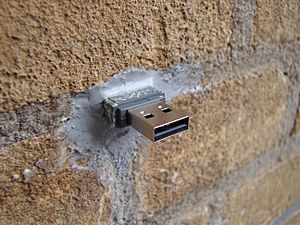USB dead drop facts for kids
A USB dead drop is a USB storage device placed in a public space. Think of it like a hidden USB stick in a wall. People can plug their laptops, smartphones, or tablets into it. This lets them share files with others. It's like an anonymous, offline way to share data. USB dead drops are often used for fun, art, or social reasons, not just for practical file sharing.
Contents
History of USB Dead Drops
The idea for Dead Drops came from Aram Bartholl, an artist from Berlin. He was part of a group called F.A.T. Lab. In October 2010, Bartholl started the first USB dead drop network. He set up five devices in Brooklyn, New York City. The name "dead drop" comes from a secret way spies used to share messages.
When a dead drop is set up, it usually has only two files. These are a manifesto (an explanation of the project) and a readme.txt file. Most dead drops are found in cities, built into concrete or brick walls. However, some have also been placed in trees or other natural spots since 2013. There are also "wireless" dead drops, like the PirateBox. With these, you connect to a Wi-Fi hotspot instead of plugging into a USB device.
Why Use USB Dead Drops?
USB dead drops offer some cool benefits:
- No Internet Needed: You can share files without any internet or phone connection.
- Secret Sharing: They allow you to share files anonymously. No one records your IP address or personal details.
- Fun and Art: Many people use them for social or artistic projects. It's a way to promote "datalove" and off-grid data networks.
- Thrill of Discovery: Finding a dead drop is like a treasure hunt, similar to geocaching. You get excited finding the location and then seeing what files are inside. Some dead drops even use QR codes to help you find them.
Things to Watch Out For
Connecting to a public USB device can have some risks. Here are a few:
- Malware: Someone might accidentally or purposely put harmful software on the dead drop. This could be a trojan horse or a keylogger. This software could infect your computer. You can reduce this risk by using antivirus software. Or, you could use a temporary device just for transferring files.
- Physical Damage: A fake dead drop might be set up to damage your device. This is called a USB Killer. It could harm your laptop or phone. You can use a special adapter called a USB galvanic isolation adapter to protect your device. Wi-Fi based dead drops don't have this risk.
- Safety in Public: Dead drops are in public places. This means someone might watch the location and try to rob you. They know you will have a consumer electronics device like a laptop with you. This is similar to the risk of being robbed near an ATM at night.
Challenges for Dead Drop Systems
While dead drops are cool, they also have some weaknesses compared to online networks:
- One User at a Time: Only one person can plug into a USB dead drop at a time.
- Data Can Be Lost: Anyone with physical access can delete all the files on the dead drop. They could also encrypt the data, making it unusable.
- Device Can Be Stolen: Thieves might steal the entire USB drive.
- Loss of Privacy: If a private dead drop's location becomes known, it can be watched. This means people using it might not be anonymous anymore.
- Vandalism: Someone could physically destroy the dead drop with tools like pliers or a hammer. High voltage or extreme heat could also damage it. Making the USB key harder to reach can help, but then users need an extender cable.
- Weather Damage: Dead drops are often outside, exposed to rain and snow. This can shorten their lifespan.
- Construction Damage: If a dead drop is built into a wall or sidewalk, it can be destroyed during construction or maintenance. Sometimes, they get damaged when walls are repainted.
How Many Dead Drops Are There?
By 2013, there were over a thousand known USB dead drops. There were also six known Wi-Fi based dead drops. Many of these were in the United States and Europe. By 2016, it was thought that all dead drops together held more than ten terabytes of data. Most were still in the US and Europe. But many devices were also reported in Asia/Pacific, South America, and Africa.
See also
 In Spanish: Dead drop (USB) para niños
In Spanish: Dead drop (USB) para niños
- Dead drop
- Sneakernet
- Geocache
- File sharing
- Technological utopianism


